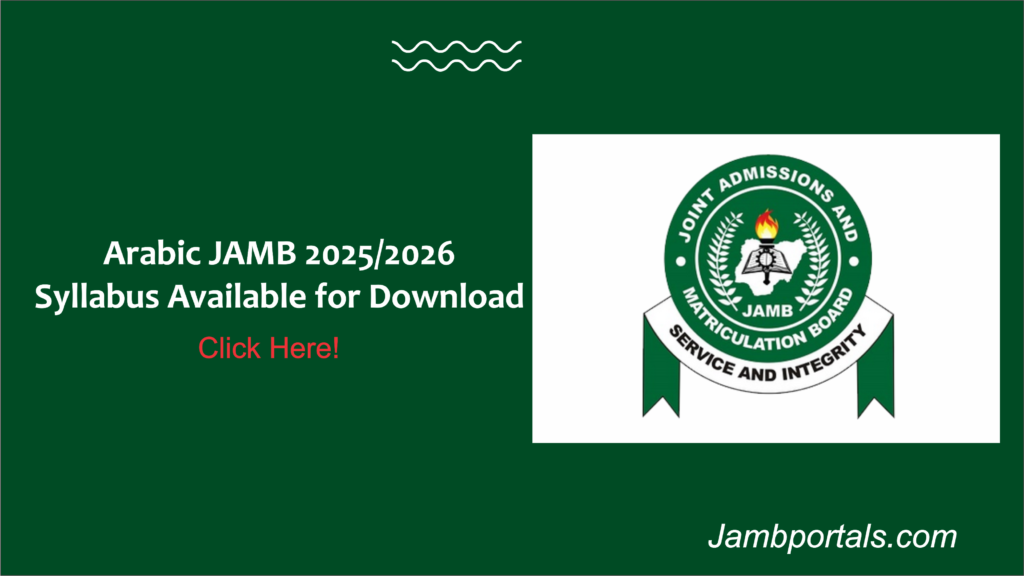
The Joint Admissions and Matriculation Board (JAMB) Arabic syllabus for the 2025 Unified Tertiary Matriculation Examination (UTME) is out online and available for download on this page.
| Examination Type | UTME / Direct Entry |
| Examination Year | 2025/2026 |
| Syllabus | Arabic |
| File Format | |
| File Size | 283KB |
Arabic, a language rich in history and cultural significance, is one of the subjects written in JAMB UTME. For candidates seeking admission into any Arabic related course, a solid understanding of the JAMB Arabic Syllabus is crucial.
The JAMB 2025 Arabic syllabus is structured to comprehensively assess your proficiency these five key areas:
- Reading Comprehension
- Writing Skills
- Translation
- Listening Comprehension
- Oral Expression
Tips to Conquer the Syllabus
Understanding the syllabus is the first step to success. First of all you need to utilize textbooks, online platforms, and Arabic media to immerse yourself in the language.
Practice JAMB Arabic past questions papers to familiarize yourself with the exam format and question types.
Regularly reviewing grammar rules, practicing composition writing, and engaging with Arabic literature contribute to a deeper understanding of the language.
Recommended: Free Download of the JAMB 2025/2026 Syllabus PDF: Syllabus System (IBASS)
JAMB 2025 Syllabus for Arabic
General Objectives
- Answer comprehension questions correctly in standard Arabic
- Translate simple texts from English to Arabic and vice versa
- Apply the rules of Arabic grammar functionally
- Appreciate Arabic literary texts within the contexts of their environment and eras
- Use Arabic as a living world language in communication where necessary
| TOPICS/CONTENTS/NOTES | OBJECTIVES |
|---|---|
| SECTION A: COMPREHENSION It consists of a passage of seventy (70) words. Five multiple-choice questions are to be set on the passage. The contents should be within the experience of the candidates e.g. current affairs, sports, education, politics, economy, health, culture and ethics. | Candidates should be able to: i. use appropriate words or phrases for specific thought ii. deduce the lesson in the passage iii. determine the main themes of the passage iv. give an appropriate title to the passage v. interpret the meanings of particular words |
| SECTION B: TRANSLATION This section consists of ten (10) questions. Five of them are on translation from English into Arabic while the other five are on translation from Arabic into English. Translation into English includes key words and phrases in a sentence. Translated questions are to be based on standard Arabic and English usages. | Candidates should be able to: i. use an appropriate Arabic word or phrase to convey the meaning of an English word or phrase ii. determine an appropriate English word or phrase for an Arabic statement iii. interpret idiomatic expressions in both Arabic and English iv. transfer ideas expressed in Arabic to English and vice versa v. communicate effectively in Arabic and English. |
| SECTION C: GRAMMAR Major grammatical features in Arabic to be examined include: 1 أسماء اإلشارة والموصولة والشرط واالستفهام. -17 المشتقات: Demonstrative, relative, conditional and interrogative pronouns. .2 المذكر والمؤنث. Gender (Masculine and Feminine). .3 عالمات االسم. Characteristics of noun. .4 المثنى. Dual. .5 الجموع: Plurals: أ – جمع المذكر السالم. a. sound masculine plural ب – جمع المؤنث السالم b. sound feminine plural ج – جمع التكسير c. broken plural .6 المضاف والمضاف إليه. Construct phrases. .7 الضمائر المنفصلة و المتصلة Separable and inseparable pronouns. .8 التوابع: Appendants: أ – النعت. ;adjective .a ب – العطف. ;conjunction .b c. the permutative; .البدل – ج د – التوكيد. .emphasis .d .9 حروف الجر والنصب والجزم Prepositions. .10 الفعل الالزم والفعل المتعدي. Transitive & Intransitive verbs. .11 الفعل الماضي The perfect verb. .12 فعل المضارع: The imperfect verb: a. the indicative. المرفوع – أ b. the subjunctive. المنصوب – ب c. the jussive. .المجزوم – ج .13 فعل األمر. The imperative verb. .14 النواسخ: The modifiers: أ – كان و أخواتها a. Kana and its associates ب – إن و أخواتها b. Inna and its associates ج – ظن و أخواتها c. Zanna and its associates .15 الفعل الثالثي المجرد و المزيد فيه. Trilateral and derived verb. .16 المصدر. Verbal noun. 17- Derivatives: أ – اسم الفاعل. a. active participle. ب- اسم المفعول. b. passive participle. ج- اسم التفضيل. c. comparative/superlative. هـ – اسم اآللة. d. noun of instrument. و – اسما الزمان و المكان. e. nouns of time and place. ز – اسم النسبة. f. relative adjective. ح- اسم المبالغة g. hyperbole noun. .18 الجملة الشرطية Conditional sentence. .19 العدد )1 – 1000 فقط( Numeral (1 – 1000). .20 الفاعل و نائب الفاعل. Active and passive voices. .21 المبتدأ والخبر. Subject and predicate. .22 منصوبات األسماء: Nouns in the accusative أ – المفعول به. a. direct object; ب – المفعول فيه )ظرف(. b. adverbs of place and time; ج – الحال. c. adverb of circumstance; د – المستثنى بإال. d. the exempted with illa; هـ – التمييز. e. the specification; و – المنادى. f. the vocative. | Candidates should be able to: i. identify the various forms of demonstrative and relative pronouns ii. compare gender markers in Arabic iii. identify the characteristics of Arabic nouns iv. differentiate between singular and dual forms of nouns v. construct plural forms of singular nouns vi. identify and construct phrases and their usages; vii. differentiate between separable and inseparable pronouns viii. identify correct usage of adjectives, conjunctions, permutative and emphasis in Arabic sentences ix. apply correct preposition particles in a given sentence x. differentiate between transitive and intransitive verbs and use them in sentences xi. identify the perfect verbs and their forms xii. identify the imperfect verbs and their grammatical words in sentences xiii.identify the imperative verbs and their forms xiv. identify the kinds of modifiers and apply them in Arabic usage xv. differentiate between trilateral and derived verbs xvi. identify the types of derivatives xvii. apply the rules governing conditional sentences, identify, construct and differentiate them in normal sentences xviii. recognise and count Arabic numerals from 1 to 1000 and identify the intricacies involved in their usage xix. distinguish between doer and doer-substitute and apply them in sentences xx. identify different types of adverbial clauses, the exempted, specification and the vocative and use them in standard Arabic. |
Download JAMB 2025 Syllabus for Arabic
Click the button below to download the full 2025 Arabic syllabus on your smartphone or laptop.
FAQs
Is mathematics compulsory in JAMB 2025?
This depends on your course of study. Mathematics is compulsory for most science subjects like Engineering.


